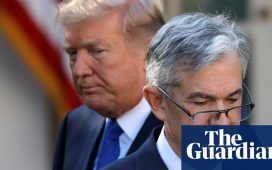Unlock the Editor’s Digest for free
Roula Khalaf, Editor of the FT, selects her favourite stories in this weekly newsletter.
Good morning. US stocks notched back-to-back daily gains for the first time in a while yesterday after a volatile three weeks. We will see if the calm mood holds in the wake of last night’s debate. Email us your thoughts: robert.armstrong@ft.com and aiden.reiter@ft.com.
What small cap revolution?
Six weeks ago we wrote about what looked like the start of a small cap revolution. Small caps, after years of underperformance, went berserk for a week after good inflation data stoked rate-cut hopes. We wondered: was this a blip, or a shift in leadership?
It was a blip. Since that strange week, big caps are back in the driver’s seat.

While we have seen a leadership change in the index, as tech stocks have fallen behind defensives and interest rate plays, small caps are lagging again.
The standard rationale for a small cap renaissance is two-fold. Small caps are more indebted, we are told, so they are disproportionately affected by higher interest rates. Interest rate cuts should therefore benefit them more. And small caps are more economically sensitive and have reacted poorly to the turbulence of the past few years. If the Fed achieves a soft landing, discounted small cap stocks could take off.
The Fed will start cutting rates this month, and the US economy is on track for a soft landing. So there is still hope out there for small caps. But we are a bit sceptical.
Start with business performance. Yesterday, we discussed how S&P 500 net profit margins have been expanding for years. Part of the explanation is that the Big Tech companies, which have become a larger part of the index, have wide margins. Though margins are increasing for small caps too, the big companies are increasing their lead. Here are the spreads in net margins between the S&P 100, which includes only the very largest US companies, and the merely large S&P 500, the mid-cap S&P 400 and the small cap S&P 600:

Small companies have been falling further behind big ones in profitability. Recently, part of this is likely down to just how much pricing power the big companies enjoyed during the pandemic, but the trend is older than that. Ian Harnett of Absolute Strategy noted to us that this may also reflect big companies squeezing smaller suppliers. It is also possible, as we mentioned in July, that private equity has been buying up the most profitable small companies. But whatever the causes, there is little reason to expect this long-standing trend to change any time soon.
There is some truth to the idea that small caps have been hit harder than large caps by higher interest rates, and will therefore receive more relief when rates fall. But only some. We compared non-financial companies in the S&P 600 in 2019 and 2023. In 2023, net interest expense was not larger relative to operating earnings than in 2019, and the aggregate interest rate the companies paid on their debt was only barely higher. The burden of debt, in other words, hardly increased as rates rose, because profit grew faster than debt payments. Small caps don’t have all that much to gain from falling rates.
What did happen is that for the big companies in the S&P 500, the debt burden actually fell between 2019 and 2023, because operating profits rose so much, and the effective interest rate actually fell, as many companies refinanced before the Fed started to increase rates.
Small caps are still cheap relative to big caps on a price/earnings basis. And, according to Charles Cara at Absolute Strategy, “some of the large small cap companies that experienced a collapse of aggregate margins [during 2020] are starting to see an improvement”.
But it seems unlikely, at least to us, that we will see a dramatic small cap renaissance. Margins and debt point towards only modest gains, relative to larger companies. We are also not yet clear on the economic outlook. Though signs are pointing to a soft landing, there could still be economic turbulence after rates fall, which would hurt cyclical small caps. From Jon Adams at Calamos Wealth Management:
The overall takeaway is we are not quite there on declaring time for small caps to outperform. We are monitoring them closely, small caps did show signs in July of being able to outperform, [but] have since trailed. We need to see more evidence on the rate cut outlook . . . and whether there will be a slowing economy.
(Armstrong and Reiter)
One good read
FT Unhedged podcast

Can’t get enough of Unhedged? Listen to our new podcast, for a 15-minute dive into the latest markets news and financial headlines, twice a week. Catch up on past editions of the newsletter here.









